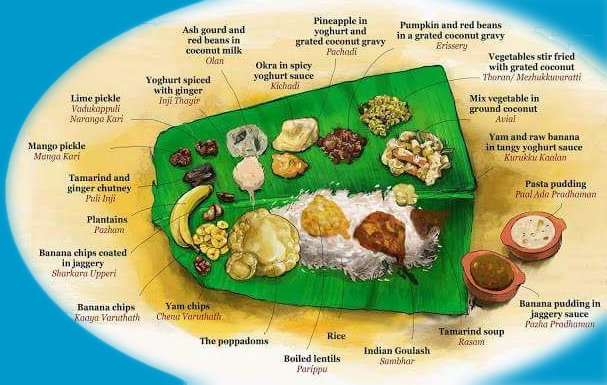Sadya (Malayalam: സദ്യ) means banquet in Malayalam. It is a typical feast of the people of Kerala

Sadya is traditionally a vegetarian meal served on a banana leaf. People are seated cross-legged on the floor on a mat. All the dishes are served on the leaf and eaten with the hands without using any cutlery. The fingers are cupped to form a ladle. A Sadya can have about 24-28 dishes served as a single course.
The main dish is plain boiled rice, served along with other dishes collectively called Kootan (കൂട്ടാന്) which include curries like parippu,Sambar , rasam, pulisseri and others like kaalan, avial, thoran, olan,pachadi, mango achar ,naranga curry , as well as papadum, banana, plain yogurt or buttermilk, and plantain chips. The traditional dessert called Payasam served at the end of the meal is of many kinds and usually three or more are served. The 'Kootan' are made with different vegetables and have different flavours; some say the reason for including so many dishes in the Sadya is to ensure that the diners will like at least two or three dishes.
The most common ingredients in all the dishes are coconut and coconut oil as they are abundant in Kerala. Coconut milk also finds various uses in cooking. Coconut oil is used for frying and also as an ingredient .
The dishes are served on specific places on the banana leaf in specific order. For example, the pickles are served on the top left corner and the banana on the bottom left corner, which helps the waiters to easily identify and decide on offering additional servings.
There are variations in the menu depending on the place and religion. Some communities,especially those in the northern part of Kerala, include non-vegetarian dishes in the sadya. Although custom was to use traditional and seasonal vegetables, it has become common practice to include vegetables such as carrots, pineapples, beans in the dishes. Tradition has it that Onion and garlic are not typically used in the sadya.
The sadya is usually served for lunch. Preparations begin the night before, and the dishes are prepared before ten o' clock in the morning on the day of the celebration. On many occasions, sadya is served on tables, as people no longer find it convenient to sit on the floor.
Traditionally, the people of the neighbourhood spent the night helping the cooks in cooking. (like scraping coconut and slicing vegetables) They also volunteer to serve the food for the hosts to the guests. This involves a fair amount of social intercourse which help build rapport with the neighbours.
Conventionally, the meal may be followed by vettila murukkan, chewing of betel leaf with lime and arecanut. This helps digestion of the meal and also cleanses the palate.
The usual items in a Sadya
Parippu : A thick curry lentil dish eaten with rice, papadum and ghee.
Sambar : A thick gravy made of lentils, tamarind, vegetables like drumsticks, tomato, etc., and flavored with asafoetida.
Rasam : A watery dish made of tamarind, tomatoes, and spices like black pepper, asafoetida, coriander, chili pepper, etc. It is very spicy in taste and aids in digestion.
Aviyal : Thick mixture of various vegetables, and coconut. It is seasoned with coconut oil and curry leaves. This dish is usually made of leftover vegetables.
Kaalan : Made of yogurt, coconut, and any one vegetable like "nendran" plantain or a tuber-like yam. It is very thick and more sour
Olan : A preparation of pumpkin, coconut milk, and ginger seasoned with coconut oil.
Koottukari : One or two vegetables like banana and coconut with a hot and sweet taste.
Kichadi : Made of yogurt and cucumber in raw or cooked form.
Pachadi : A sweet form of kichadi, but made with pineapple, grapes and coconut.
Puliyinchi : A dish of paste like consistency made of ginger, tamarind, green chilies, and jaggery.
Thoran : A dish of sauted vegetables such as peas, green beans, raw jackfruit, carrots, or cabbage (usually) with grated coconut.
Pickles (Achar) : Spicy pickled raw mango/lemon/lime, etc.
